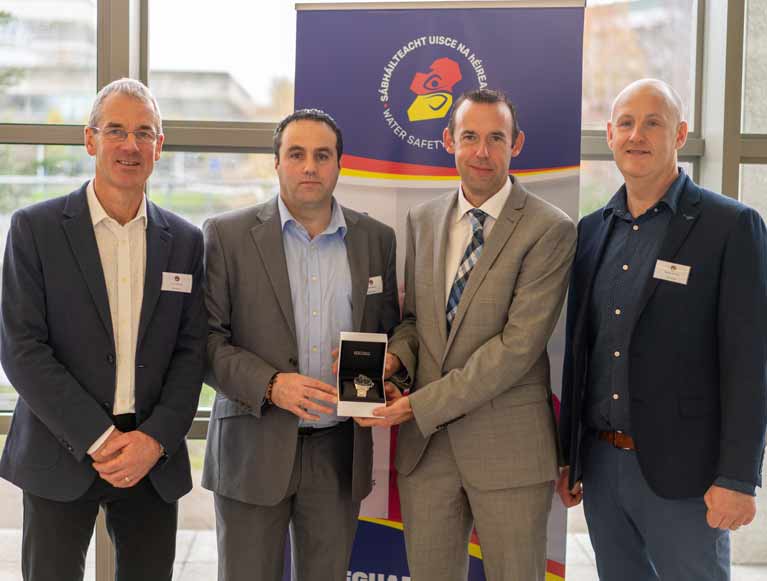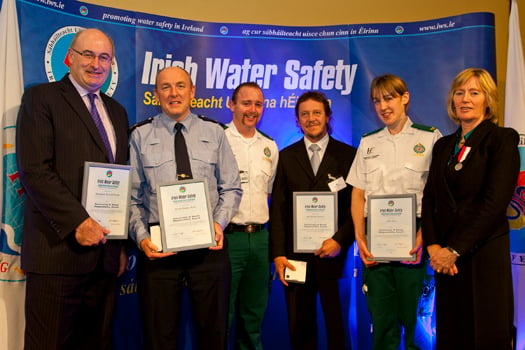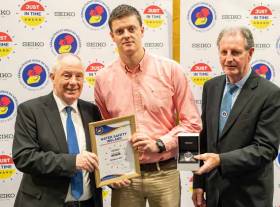Displaying items by tag: Just in Time Awards
Water Safety Ireland Honours Remarkable Rescuers In National Awards
Seventeen lives were saved from drowning by rescuers who will receive recognition at Water Safety Ireland’s National Annual Awards Ceremony at the O’Reilly Hall in UCD this afternoon (Tuesday 26 November).
Michael Ring, Minister for Rural & Community Development, will present the Seiko Just in Time Rescue Award to the rescuers in appreciation for saving so many lives.
“It is an honour to pay tribute to these deserving award recipients”, commented Minister Ring. “Without their bravery, quick thinking and selflessness, the outcomes could have been very different.
 Cyril McKeon, Damien McCabe and Paul Gilmartin – Leitrim On the 6th of May 2018, a training session almost resulted in disaster for a prospective marathon runner. While preparing for an upcoming event, the man fell into the canal at Blueway Waterway. Luckily, Cyril McKeon, Damien McCabe and Paul Gilmartin were on hand as they too were training along the canal. After hearing a splash in the water all three raced to the gentleman’s assistance. The men performed CPR and made sure ambulance personnel were called to the scene
Cyril McKeon, Damien McCabe and Paul Gilmartin – Leitrim On the 6th of May 2018, a training session almost resulted in disaster for a prospective marathon runner. While preparing for an upcoming event, the man fell into the canal at Blueway Waterway. Luckily, Cyril McKeon, Damien McCabe and Paul Gilmartin were on hand as they too were training along the canal. After hearing a splash in the water all three raced to the gentleman’s assistance. The men performed CPR and made sure ambulance personnel were called to the scene
“On average 124 people drown annually in Ireland and while one drowning is one too many, the figure would have been higher but for these courageous rescuers.”
Among the Just in Time Award recipients this year is Dr Matthew Sims, who rushed into the water with a rescue tube to help an adult brother and sister caught in a rip current at Tramore beach on 5 August this year.
Speaking to RTÉ’s News at One earlier today, Dr Sims said he was “just glad he was able to help”.
Others recognised this year include surfer Tom Green from Co Clare, who two months ago broke from the heats of his surfing competition to help two swimmers struggling in the water nearby; kayaker Tom Upritchard, who rescued his own father after he went overboard at Craigavon Watersport Centre on 15 August; and gardaí stationed in Dublin, Donegal and Kilkenny for various quick-thinking efforts.
Recipients also include 61 volunteers who will be presented with Long-Service Volunteer Awards, recognising a combined total of 1,275 years of personal service teaching swimming, water rescue and survival skills in communities nationwide.
“I would like to commend the efforts of Water Safety Ireland volunteers who devote their time and contribute to the year on year trend of reduced drownings”, Minister Ring added.
“The lifeguard service is also crucial to safety on our waterways and would not be possible without the teaching and assessment conducted by Water Safety Ireland Volunteers nationwide.
“This summer, lifeguards rescued 260 people from drowning, administered first aid on 3, 284 occasions and reunited with loved ones 289 lost children found wandering unsupervised near water.”
“I would ask all adults to make themselves more aware of the dangers of drowning,” said Martin O’Sullivan, chairman of Water Safety Ireland.
“Tragedy can strike in seconds but with the right knowledge, skills and attitudes everyone can avoid the hazards and take responsibility for their own safety.
“Encourage your family, friends and colleagues to read Water Safety Ireland’s guidelines at watersafety.ie so that they can enjoy Ireland’s waterways safely.”
Teen Surfers Honoured for Saving Boy from Drowning
#WATER SAFETY - Two teenage surfers have been honoured for their brave effort in rescuing a young boy from drowning earlier this year, The Irish Times reports.
Bernard Cahill, 17, and Donough Cronin, 16, from Ennis received Just in Time Awards at Irish Water Safety's annual awards ceremony in Dublin Castle on Tuesday.

The duo were recognised for going to the aid of nine-year-old Gearóid Rogers, who was caught in a rip current near Spanish Point with his father Ger.
The Rogers family paid tribute to the surfing teens at the ceremony, with Ger saying he and his son were "lucky to be alive" thanks to their actions.






























































